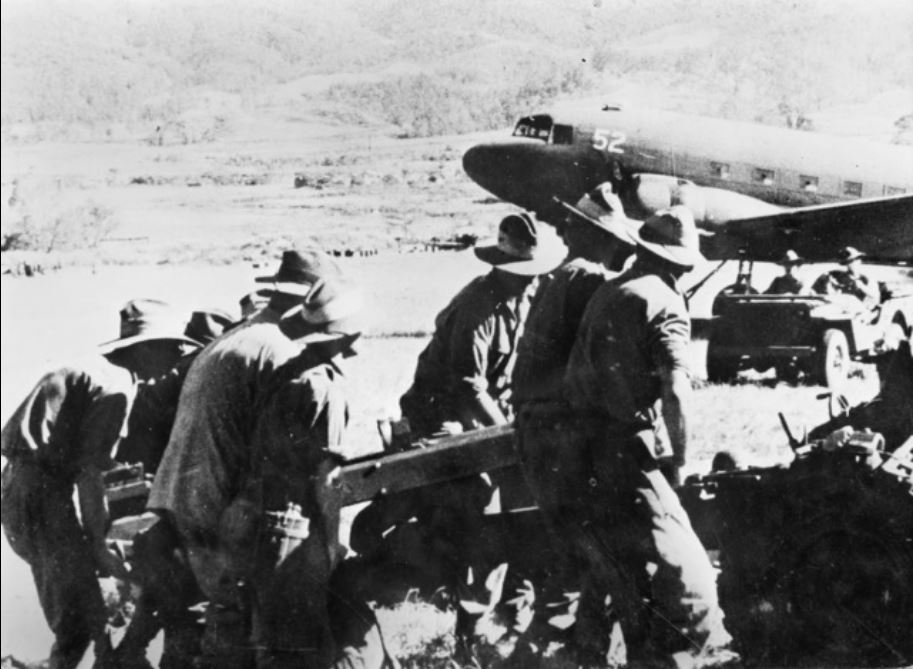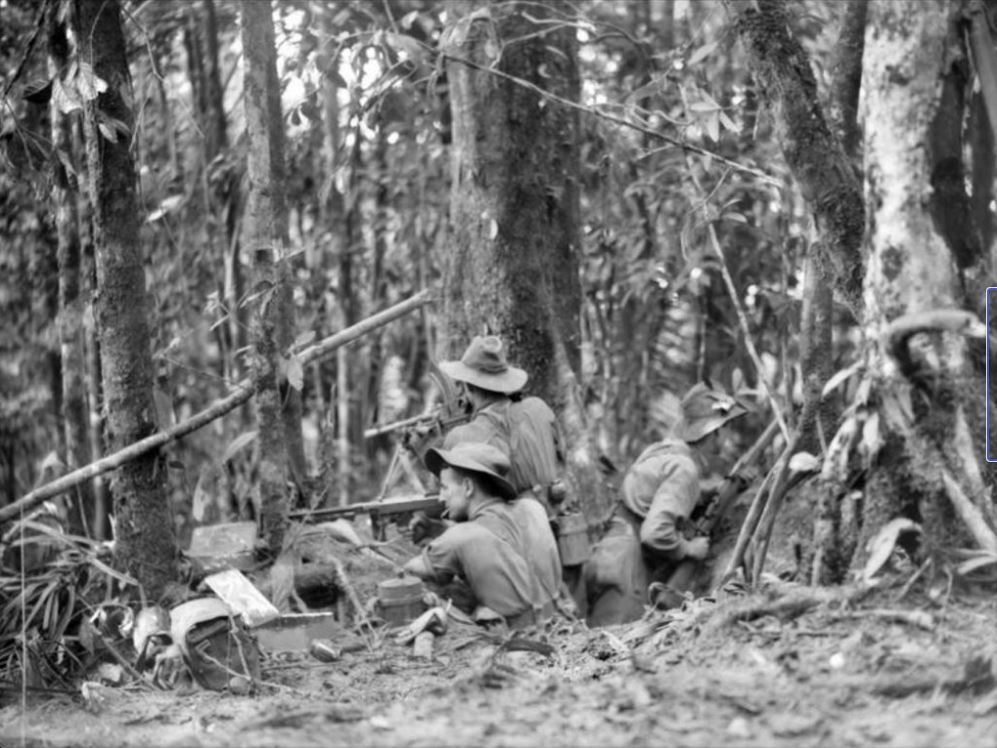6th Australian Infantry Division Signals Company
From Our Contribution
 25 pounder artillery being unloaded at Wau. AWM photo | |
 July 1943 - 2/5th soldiers near Mount Tambo. AWM photo 156767 | |
Brief History
The 6th Division was first formed in 1917 in Britain during World War I as part of an effort to expand the First Australian Imperial Force. Its existence was short-lived, due to manpower shortages. The 6th Division was the first division formed within the 2nd AIF, being raised on 28 September 1939. Of the division's infantry battalions, all except one – the 2/11th – were raised in either New South Wales or Victoria. In early 1940, the majority of the 6th Division was sent to Palestine, to complete their training before joining the British Expeditionary Force (BEF) in France. The fall of France saw them remain in the Middle East.
The 6th Division first saw action in early 1941, against Italian forces in North Africa, in the advance to Benghazi. On 3 Jan 1941, at Bardia, a small coastal town just inside the Libyan border, the first major Australian action of World War II took place. Amidst a heavy artillery barrage and supported by British Matilda tanks and Bren carriers of the divisional cavalry, the 6th Division penetrated the defences of the Italian stronghold. Despite some heavy resistance the town fell to the Australians just two days later. The Allies took nearly 40,000 Italian prisoners and considerable amounts of enemy weapons, supplies and equipment. On 22 Jan 1941, the Italian held port of Tobruk fell to the 2nd AIF and 25,000 Italians became prisoners. During January and February 1941, the 6th Division, together with British units, pushed the Italian army back across Libya, including actions at Derna, Barce and Benghazi. Losses in north Africa amounted to 241 killed, 790 wounded and 21 captured.
Amid concerns that the Germans were likely to invade Greece to help out the failed Italian invasion, the 6th Australian Infantry Division was sent to assist the Greek defence, arriving in Greece in late March and early April 1941. Transported north towards the Yugoslav border, they established defensive positions, but were unable to stop an Army that had deployed 27 Divisions against them. Unable to hold the German's as many as possible were evacuated, most to Crete, although they had lost 320 killed, 494 wounded, and 2,030 captured. Those on Crete had left all of their equipment behind and were organised into composite rifle units to prepare for the likely German invasion of the island. Crete was another disaster, ill equipped troops try to defend the island against an aerial assault. When their ammunition ran out, a small number were able to evacuate to Egypt, but again many were left behind. Another 274 were killed, 507 wounded, and 3,102 captured. Those who escaped were to form the nucleus as the Division was rebuilt in Palestine. Meanwhile some elements that had not participated in the Greece / Crete campaign participated in the attack on Vichy French troops in Lebanon and Syria, with 39 killed and 129 wounded.
On the voyage back to Australia two of the three Brigades (16th and 17th) were retained in Ceylon (Sri Lanka) for nearly six months in case of a Japanese attack. In Australia the 19th Brigade's 2/11th Battalion was utilised for Garrison duties in Western Australia, while the rest were sent to the Northern Territory. In mid September 1942 the 16th Brigade was sent to New Guinea to reinforce those fighting the Japanese on the Kokoda Track, the 17th Brigade to Milne Bay. By the time the 16th Brigade's units were withdrawn from the conflict they lost 207 killed and 397 wounded. Meanwhile the 17th Brigade was held at Milne Bay until it was used to reinforce the Wau and Salamaua–Lae campaign, with units fighting until Salamaua fell on 20 Sep 1943. The campaign cost the 6th Division 240 killed and 50 wounded before it was relieved and sent back to Australia to rebuild.
Following a lengthy wait on the Atherton Tablelands in far north Queensland for their next role in November 1944 they were committed to the Aitape - Wewak campaign. US troops had undertaken an amphibious landing around Aitape, but the Australians were needed to relieve them and to clearing the remaining Japanese troops from the area. Limited shipping meant that the arrival of 6th Division units was spread over several months. Slow progress was made due to the topography, but Maprik was captured om 23 April, and Wewak on 11 May. Units of the 6th Division continued to press south in pursuit of the Japanese until the end of the war.
Unit Personnel
- William George Ward 24 Jun 1940 - 22 Apr 1941
- Edmond Hepple Brown MID 9 Jul 1940 - 17 Aug 1945
- Geoffrey Gordon Benson 9 Jun 1941 - 9 Jun 1942
Notes
Content has come from Wikipedia [1]